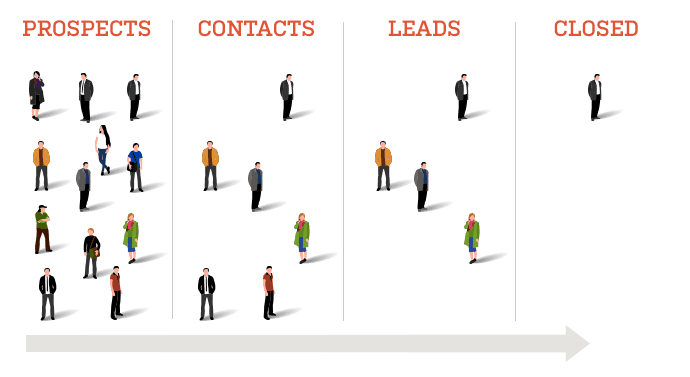What is a Qualified Lead?
In organizations that sell products and services B2B, marketing and sales teams work together to build a marketing/sales funnel, nurture prospects through each stage of the customer journey and generate new revenue for the business. A typical customer journey consists of at least four touchpoints for the customer:
- First touch
- Lead
- Opportunity
- Closed customer
In most organizations, the marketing team is responsible for getting the attention of prospective customers, converting them into leads and turning those leads into opportunities for the sales department. The sales team is responsible for turning opportunities into closed customers.
A qualified lead, sometimes called a sales qualified lead (SQL) is a prospective customer that has met pre-determined criteria indicating they are sales-ready. An opportunity and a sales qualified lead are, for all intents and purposes, the same thing. Lead qualification is the process that turns an unqualified lead into an opportunity for the sales team by determining whether the lead meets the pre-determined criteria.
The biggest challenge associated with generating qualified leads is lead definition – the establishment of a formal definition for a qualified lead.

Why is it Important to Define a Qualified Lead?
Sales and marketing teams collaborate to effectively manage the customer journey and to deliver the right message to the right prospect at the right time that encourages a sale. Without a common, formalized definition of what constitutes a lead, or what criteria must be met for a lead to be converted into an opportunity, how can marketing teams determine which leads should be passed on to sales? How can sales teams ensure that they are communicating the right messages to prospects that are ready to buy?
To ensure that customers are nurtured appropriately throughout the customer journey, marketing and sales must agree on a definition of a qualified lead. The ability to track individual behavior and engagement for each prospect, along with clearly established criteria for every step of the customer journey, ensures that leads are appropriately qualified before they are passed to the sales team as opportunities.
Establishing a formalized definition of a qualified lead promotes alignment between marketing and sales teams, reduces inefficiency, improves the customer experience and ultimately drives revenue and sales growth for the organization.

Qualified Lead Definitions and Why They Matter
Consider how the following data reveals a lack of alignment between sales and marketing at some of the world’s top sales organizations:
In their 2014 Sales Performance Optimization Analysis report, CSO insights published data indicating that lead definition was an area of opportunity for improving alignment between sales and marketing. At the time, 49.7% of organizations reported that sales and marketing had a formalized definition of a qualified lead, 31.1% had an informal definition, and 19.3% organizations had no formal definition of a qualified lead.
Five years later, CSO published a 2019 version of the same report. Shockingly, it was reported that the ratio of organizations with a formalized definition of a qualified lead had actually fallen from 49.7% in 2014 to 29.5% in 2017! In addition, 43% of organizations in 2017 reported that they had no formal definition of a qualified lead.
Research also shows that just 34% of organizations without a common lead definition were able to convert leads into sales conversations more than half the time. In contrast, 63% of organizations with a clear definition for a qualified lead were able to convert more than half of leads into sales conversions. The best available data shows that establishing a clear definition for a qualified leads results in improved marketing/sales alignment that can actually drive conversions.
How to Define a Qualified Lead
Marketing and sales teams should work together to establish a shared definition of a qualified lead. This definition will be applied to the customer journey and used to determine when a lead becomes an opportunity that can be passed to the sales team. Below are some common criteria used to qualify leads:
Ideal Customer Profile
An ideal customer profile is a description of a target company that would be the perfect candidate to purchase your product. The profile might be constructed as a list of 10 descriptors or criteria that reflect an ideal customer. The more of these criteria that an individual lead satisfies, the more we may be inclined to call them a “qualified lead”. An ideal customer profile should include:
- A target market sector or industry vertical
- Annual revenue
- Budget
- Geography
- Current technology or level of technological investment
- Number of customers
- Level of maturity (organizational, technological, etc.)
- Number of employees (in organization, department or on location)
Engagement/Behavior
Your organization may choose to qualify leads that have demonstrated specified behaviors while interacting with your brand or have displayed other positive signs of customer engagement. Qualified leads could be defined as those that have:
- Completed your customer nurturing campaign
- Engaged with your company, brand or product across a specified number of marketing touchpoints
- Spent some amount of time on your website or viewed a set number of resources
- Provided their contact information through multiple marketing touchpoints or intake forms
Communications
One of the best ways to distinguish between a qualified lead and an unqualified one is simple communication. Sometimes leads will qualify themselves through your contact forms or an e-mail stating their interest in receiving a free proposal or demo of your product. Members of the marketing or sales team may reach out to prospects and attempt to qualify them in a conversation by asking “qualifying questions”.
However, an organization chooses to define a qualified lead, establishing a common definition that can be shared between marketing and sales teams is a necessary component of optimizing the customer experience throughout the purchasing journey.

Directive Consulting Uses Closed-Loop Analytics to Define Qualified Leads
At Directive Consulting, we’ve got our own approach to defining qualified leads: closed-loop marketing.
We use user behavior tracking and marketing analytics to track individual prospects throughout the entire purchasing process, from their first contact with your organization through to the purchase.
When a sale happens, we correlate the outcome of the sale with every other data point we’ve collected on the customer. We include engagement and interactive behavior with your brand, communications, and customer profile data. Then, we feed that back into our marketing software to help us understand which characteristics and behaviors most strongly correlate with lead quality for your specific business and industry.
This allows us to create complex, data-driven formulas for assessing lead quality and helps identify the most qualified leads from any point in the marketing funnel.
Contact us for a free proposal and see how our closed-loop analytics system can help define a qualified lead for your organization, and get you more of them.